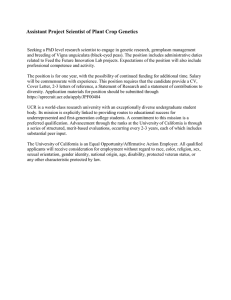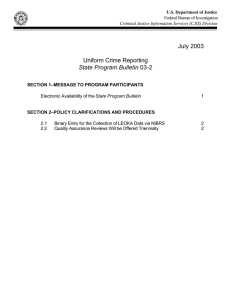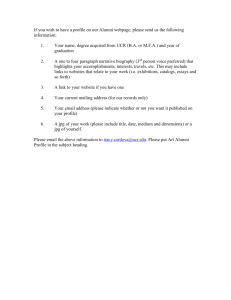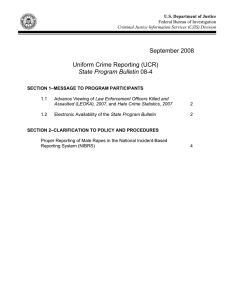July 2002 Uniform Crime Reporting State Program Bulletin
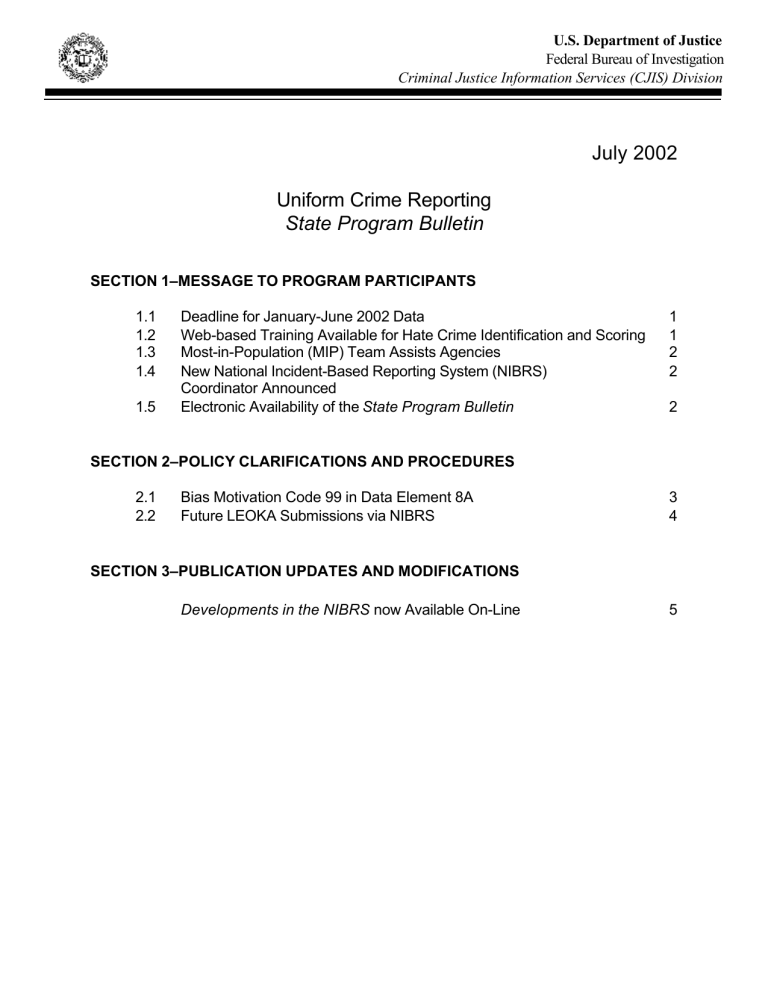
U.S. Department of Justice
Federal Bureau of Investigation
Criminal Justice Information Services (CJIS) Division
July 2002
Uniform Crime Reporting
State Program Bulletin
SECTION 1–MESSAGE TO PROGRAM PARTICIPANTS
1.1 Deadline for January-June 2002 Data
1.4
New National Incident-Based Reporting System (NIBRS)
Coordinator Announced
1
1.2
Web-based Training Available for Hate Crime Identification and Scoring 1
1.3
Most-in-Population (MIP) Team Assists Agencies 2
2
1.5
Electronic Availability of the State Program Bulletin 2
SECTION 2–POLICY CLARIFICATIONS AND PROCEDURES
2.1 Bias Motivation Code 99 in Data Element 8A
2.2
Future LEOKA Submissions via NIBRS
3
4
SECTION 3–PUBLICATION UPDATES AND MODIFICATIONS
Developments in the NIBRS now Available On-Line 5
SECTION 1–MESSAGE TO PROGRAM PARTICIPANTS
1.1
Deadline for January-June 2002 Data
State Uniform Crime Reporting (UCR) Program managers who have not previously provided monthly submissions for January-June 2002 should submit all of those data to the FBI’s Crime Statistics
Management Unit (CSMU) by Friday, August 30, 2002.
Your adherence to this deadline is important so that CSMU staff can process 2002 data for all participating agencies including those that will be published in the Preliminary Semiannual Uniform Crime Report, January-June 2002, the
Most-in-Population (MIP) agencies. Because of data processing issues, the national UCR Program will not guarantee that MIP agencies submitting data after the August 30 deadline will be published in the Preliminary Semiannual Uniform Crime Report, January-June 2002.
1.2
Web-based Training Available for Hate Crime Identification and Scoring
The national UCR Program recognizes the importance of good training if an individual is to perform his/her job at the best level possible. It also recognizes that because of work schedules, location, budget restrictions, and a host of other factors, training is not always easy to obtain. Consequently, the
Program has worked over 2 years to develop and test a Web-based hate crime identification and scoring training, which is now available on the Law Enforcement OnLine (LEO). The FBI’s objective was to create a course that could be a sound alternative to the face-to-face method of presenting material.
In evaluating the training, the UCR Program’s hate crime identification and scoring class was taught by two different methods of delivery. A sample composed of both sworn officers and civilian law enforcement personnel was randomly selected to receive training either in a face-to-face presentation or a course delivered via an intranet. Both courses had the same learning objectives. The efficacy of the learning technology to achieve these objectives was evaluated through the use of a pre- and posttest.
The difference in scores between the two tests was the proxy used to measure cognitive gain (or learning). The results were compared to the gains made by students in the face-to-face class. Various demographic information about the training participants was also collected, compared, and examined to see if any of this information affected cognitive gains. Additionally, the study examined separately the effects of computer anxiety and time on task on learning and also compared customer satisfaction with the two modes of instruction. The results demonstrate that there is no significant difference in the training participants’ cognitive gains between the two methods of instruction. Furthermore, of the demographic attributes, only familiarity with the material significantly affected cognitive gains in the faceto-face course and age (over 45) affected the gains made in Web-based training. Neither computer anxiety nor time on task affected the cognitive gains made in the Web-based course. Finally, students were equally satisfied with both methods of instruction.
The national UCR Program encourages those agencies wanting hate crime training to explore this Webbased option for their officers on LEO at http://home.leo.gov/special_topics/stats/main/startup.htm.
(The access path from the LEO Home Page is Special Interest Groups > CJIS > New CJIS Training
Information > Hate Crime Web-based Training.) Law enforcement personnel requiring a LEO application may call the LEO Help Desk at 888-334-4536.
UCR State Program Bulletin 02-2 1 July 2002
1.3
Most-in-Population (MIP) Team Assists Agencies
The CSMU serves as the centralized UCR data manager and point of contact for all local, state, and federal contributors to the national UCR Program. In an effort to streamline data processing, the
CSMU formed one team to work exclusively with the MIP agencies, which are cities and counties that have a population of 100,000 and above, and the issues unique to those agencies. The MIP summary agencies, totaling 309, comprise a large percentage of the crime reported in the United States.
The MIP team is responsible for all facets of data management including data submission tracking, data conformance to UCR policies and procedures, integration of data into the national database, quality review, rate and trend analyses, continual and extensive liaison activities with state Program managers and direct contributors, data quality control, and correspondence to the MIP agencies addressing data discrepancies. The team also ensures the integrity of crime data for inclusion in Crime in the United
States, Law Enforcement Officers Killed and Assaulted, and the semiannual and the annual
Preliminary Uniform Crime Reports .
1.4
New National Incident-Based Reporting System (NIBRS)
Coordinator Announced
Effective July 19, 2002, Mr. Gregory S. Swanson assumed the responsibility as the national UCR
Program’s NIBRS Coordinator. In supporting the Program’s vision for increasing NIBRS implementation and participation, Mr. Swanson will liaise with personnel both internal and external to the FBI for the purpose of coordinating NIBRS issues with the Regional Working Groups, the UCR
Subcommittee, and the CJIS Advisory Policy Board. Mr. Swanson, a Management Analyst in the
FBI’s Education/Training Services Unit, replaces Mr. Christopher L. Enourato, who is now serving in an interim position with the CJIS Division’s FBI Police Officers and Security Unit. State UCR
Program managers who have questions about implementing NIBRS or the NIBRS certification process may contact Mr. Swanson at 304-625-2998.
1.5
Electronic Availability of the State Program Bulletin
The UCR Program’s State Program Bulletin is now available electronically in Corel WordPerfect and
Microsoft Word formats. State Program managers who wish to receive the UCR State Program
Bulletin via E-mail instead of receiving hard copies through the U.S. Postal Service should provide the
FBI’s Communications Unit (CU) with their E-mail address at: cjis_comm@leo.gov.
Please indicate
State Program Bulletin in the subject line of your E-mail.
The UCR State Program Bulletin is also available via the LEO Intranet (under the Crime in the U.S.:
Uniform Crime Reports Section) at www.leo.gov/special_topics/stats/stats_home.html
. Users with questions concerning access to LEO should contact the LEO Program Office at 202-324-8833
(telephone) or the CU at 304-625-4995 (telephone) or 304-625-5394 (facsimile).
UCR State Program Bulletin 02-2 2 July 2002
SECTION 2–POLICY CLARIFICATIONS AND PROCEDURES
2.1 Bias Motivation Code 99 in Data Element 8A
A review of NIBRS data has revealed that there is a relatively high number of incidents submitted with a bias motivation code of 99 = Unknown in Data Element 8A as opposed to incidents indicating a specific bias motivation (codes 11-52) or no bias motivation (88 = None). In the 2000 data, for example, over 142,000 incidents were coded as unknown, but only 8,063 incidents were coded and subsequently published as having been motivated by some type of bias. So far, two factors have been identified in contributing to the high number of unknowns:
1) NIBRS software defaulting to 99 = Unknown.
2) A misunderstanding as to the intent and utility of 99 = Unknown.
In some cases, NIBRS software has been programmed to default to code 99 = Unknown when data entry personnel skip Data Element 8A, Bias Motivation. Currently, the national UCR Program is working with states that are known to have this problem to initiate programming changes with their
NIBRS software.
Regarding the proper use of code 99 = Unknown, page 75 of NIBRS Volume 1: Data Collection
Guidelines, (August 2000) states that “. . . incidents that do not involve any facts indicating biased motivation on the part of the offender are to be reported as 88 = None, whereas incidents involving ambiguous facts (some facts are present but are not conclusive) should be reported as 99 = Unknown.”
Statistical reasonableness checks allow that the presence of bias motivation is undeterminable in a very small percentage of incidents, which includes those under current investigation. However, the high percentage of unknowns submitted by some agencies indicates that the agency is not modifying its reports with the final results of the investigations (to show 88 = None or a specific bias motivation, codes 11-52), their investigations are inconclusive, or perhaps they are using the code as a means to avoid determining the presence or absence of bias motivation altogether.
The original intent of bias motivation code 99 = Unknown is to allow an agency the opportunity to report a crime in which bias motivation is suspected until a final decision has been made and to report those instances in which the presence of bias motivation is inconclusive. Once the incident reports are modified to indicate the results of subsequent investigations and hate crime data are finalized with yearend totals, reporting agencies should have few, if any, hate crime offenses coded with 99 = Unknown.
The national UCR Program has contacted state UCR Program managers in the states affected by excessive use of 99 = Unknown and has requested follow-up with the reporting agency(ies) so the offenses in question can be updated when possible to indicate whether or not a bias-motivated offense occurred. Careful use of code 99 will enable law enforcement to report bias-motivated criminal offenses more accurately.
UCR State Program Bulletin 02-2 3 July 2002
2.2
Future LEOKA Submissions via NIBRS
In the December 2001 State Program Bulletin, the national UCR Program announced that it would begin collecting LEOKA data at the incident level via NIBRS on June 1, 2002, through three new data elements and a series of new data codes. Due to programming delays, however, the national Program has postponed adopting the new format and has established the following alternate LEOKA submission dates:
1.
TEST DATA–Beginning October 1, 2002, the national UCR Program will begin accepting the new LEOKA format in NIBRS as test data.
2.
PRODUCTION DATA–Effective January 1, 2003, the national UCR Program will enter the new LEOKA data submissions into the NIBRS 2003 Master File and will subsequently use the data for analyses and publication purposes.
State UCR Program managers are reminded that the LEOKA reporting method, i.e., use of the new
NIBRS format (with the new LEOKA data elements and codes) or the older LEOKA data record
(specified in NIBRS Volume 2: Data Submission Specifications [May 1992], pages 36-38) must be consistent among all reporting agencies within a state. An addendum to the NIBRS volumes that will provide program modifications for reporting LEOKA data with the new NIBRS data elements will be mailed to the state NIBRS agencies this fall.
UCR State Program Bulletin 02-2 4 July 2002
SECTION 3–PUBLICATION UPDATES AND MODIFICATIONS
Developments in the NIBRS now Available On-Line
As law enforcement agencies make the Summary-to-NIBRS transition, they have called upon several different vendors to develop incident-based systems that comply with the national UCR Program’s standards yet accommodate their agency’s unique requirements. Though the FBI’s UCR Program keeps agencies up to date of the NIBRS programming changes through periodically disseminating UCR
State Program Bulletins, many agencies requested a way to ensure that the same information (minus the business of the Program) is available to the vendors. In response to these requests, the national
Program has compiled a web document entitled Developments in the NIBRS, which includes excerpts from UCR State Program Bulletins that provide a historical perspective of the evolution of NIBRS including procedural changes, reporting clarifications, and policy additions that have occurred from
1999 to present. Note: The excerpts are presented as they were originally published in the
State Program Bulletin . However, subsequent excerpts may have additions, deletions, or clarifications to those from earlier bulletins. Therefore, users are urged to read the document in its entirety before making any programming changes.
The document, which will be updated as needed, can be found at www.fbi.gov/ucr/ . From that site, users can download Adobe Acrobat 5.0 in order to view the portable document file of Developments in the NIBRS .
UCR State Program Bulletin 02-2 5 July 2002
